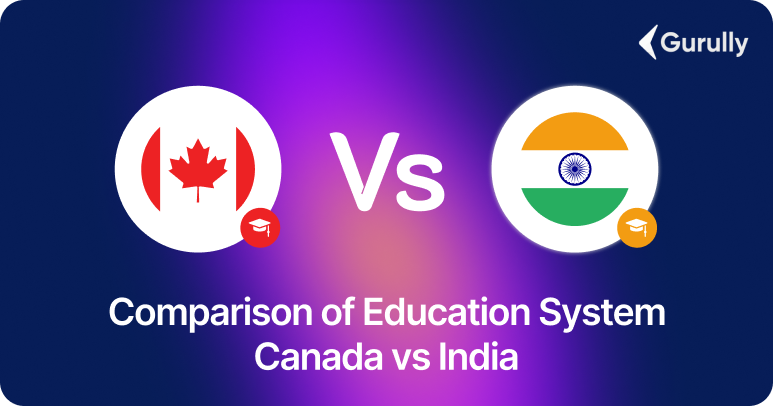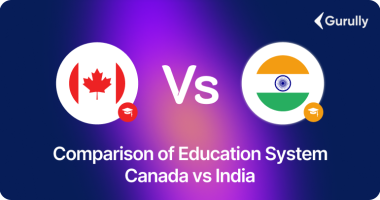Students pursuing higher education often get confused between which country to opt for, Canada or India. Well, both countries offer promising yet different pathways. So here is detailed information about education in Canada vs India.
India’s education system is usually known for its academic depth and affordability. While, Canada’s education system is globally known for its practical learning and post-study work opportunities. This blog explores how studying, working, and living differ for international students in these two countries.
Education in Canada vs India – Overview
Education in Canada
- In Canada, each province or territory has its own policy regarding the education system.
- The education system is divided into:
- Elementary: Grades 1–8
- Secondary: Grades 9–12
- Post-secondary: College/University
- One of the important aspects of Canadian universities is that they focus more on research, practical exposure, and critical thinking.
- Degrees from top Canadian universities or colleges are recognised globally with a strong focus on best work opportunities.
- Post-secondary institution maintains high standards in terms of quality through the accreditation process and regular assessments.
Education in India
- In India, a centralized multi-board system is followed under NEP (National Education Policy). The structure is:
- Primary – Grades 1–5
- Upper Primary- Grade 6–8
- Secondary – Grade 9–10
- Higher Secondary – Grade 11–12
- Undergraduate – 3–4 years
- Post-Graduated – 2 years
- Doctoral – 3-5 Years
- The National Education Policy 2020 aims to make education more skill-oriented and flexible.
- As per education.gov.in, the NEP 2020 encourages flexibility and vocational integration to align Indian education with global standards.
Work Opportunities While Studying
In Canada
- In Canada, international students can work up to 24 hours per week according to the 2024 IRCC (Immigration, Refugees and Citizenship Canada) update. Students enrolled in full-time programs at DLI(Designated Learning Institutions) are eligible for this.
- Even during academic breaks, they can work full-time without any additional permit.
- After completing the studies, you can also apply for PGWP (Post-Graduation Work Permit)-valid up to 3 years depending on the course or program.
- Through this, students gain Canadian work experience, which later on supports PR (permanent Residency) applications.
- Canadian employers value students with academic credentials and industry exposure.
In India
- In India, the part-time work opportunities for students are not formally structured. You will find these opportunities in terms of:
- Internships
- Freelancing
- Campus Jobs or teaching assistance
- Over the past few years majority of Indian Universities, especially in private institutions and metros, have been accepting industry-integrated internships.
- Though the chances of formal part-time employment for students are still limited compared to Canada.
| Parameter | Canada | India |
| Work Hours Allowed | Up to 24 hours/week | Limited; mostly internships |
| Work Authorization | Smooth for DLI Students | Not standardized |
| Post-study Options | PGWP (Valid for 3 Years) | No structured work visa |
| Industry Exposure | Extensive through co-ops and placements | Improving but limited |
| Impact on Career | Strong – helps in PR and employment | Moderate – mostly for experience |
Cost of Education:
Canada offers world-class education exposure, so the cost is comparatively high. However, the ROI (return of Investment) is justified because of better work opportunities globally. Here are the approximate annual expenses of education in Canada vs India.
| Expense Type | Canada(Approx.) | India(Approx.) |
| Undergraduate Tuition | CAD 20,000 – 35,000/year | INR 1 – 5 lakhs/year |
| Postgraduate Tuition | CAD 25,000 – 40,000/year | INR 2 – 7 lakhs/year |
| Living Expenses | CAD 15,000 – 20,000/year | INR 1.5 – 3 lakhs/year |
| Scholarships | Widely available for international students | Available but limited |
| Return on Investment (ROI) | High – due to PGWP and PR pathways | Moderate – depends on domestic market |
- Tuition and housing expenses are higher in Canada, but the perk is that students get access to global opportunities.
- Indian education is more affordable, which also includes low living expenses.
Life in Canada Vs India
Life In Canada
- Canada ranks in top 10 countries on UN HDI (Human Development Index).
- Students living in Canada benefit from a safe and multicultural environment. World-class healthcare is a major advantage.
- Cost of living, especially rent, has increased in 2024-2025, but students will enjoy cultural diversity and inclusion.
Life In India:
- India is very affordable compared to Canada, and students experience a rich culture.
- Living costs, especially renting, are affordable, and while studying in universities, you will experience a strong sense of community.
| Aspect | Canada | India |
| Quality of Life | Among the highest globally | Varies by region |
| Living Costs | High (especially rent) | Affordable |
| Healthcare | Free or subsidized for students | Affordable but varies |
| Cultural Environment | Multicultural, inclusive | Traditional with regional diversity |
| Student Life | Balanced with strong support | Community-driven and vibrant |
Career & Work Opportunities:
Canada’s systematic work visa system makes it one of the most student-friendly destinations. While in India, there are wide domestic job opportunities and salary growth.
| Parameter | Canada | India |
| Work Visa After Studies | PGWP(Post-Graduation Work Permit) up to 3 years | Structured post-study work visa not available |
| Graduate Employment Rate | Over 80% within 6 months (StatsCan) | 60–65% (varies by stream) |
| Average Starting Salary | CAD 45,000 – 55,000/year | INR 4 – 7 lakhs/year |
| Permanent Residency (PR) | Available through Express Entry & Provincial Nominee Programs | Not applicable domestically |
| Top Job Sectors | IT, Engineering, Healthcare, Business, AI, Data Science | IT, Manufacturing, Banking, Startups |
| Long-term Growth | Global exposure and stable job market | Depends on economic fluctuations and competition |
Immigration and Residency:
Canada:
- Through PGWP (Post Graduation Work Program) international students can stay back up to 3 years.
- International students can apply for PR through Express Entry or PNPs (Provincial Nominee Programs) after getting Canadian work experience.
- The immigration process is smooth, transparent, and point-based, which makes it favourable for international students.
India:
- There is no direct post-study work visa or PR system for international students in India.
- The validity of a student visa is only up to the duration of the course. After that, students have to return home.
- PR options are very limited and restricted to OCI (Overseas Citizen of India) cardholders or people of Indian origin.
These are detailed comparisons of education in Canada vs India, along with several other factors. So if you are planning to study in Canada, you must give an English language proficiency exam like PTE, IELTS, CELPIP, or Duolingo. And for scoring high in these exams, you can start your preparation at Gurully. Our platform provides a full-length mock test with real-time exam simulation. With accurate AI scoring, you will be able to track your performance and streamline preparation.
FAQ:
Is it better to study in India or Canada?
Is Canada better than India?
Which country is No. 1 in the education system?
Is living in Canada better than India?
Is it wise to move to Canada from India?
Also Read:
- 10 Top Universities in the World for Studying Abroad
- Everything You Must Know About a Student Visa Australia
- Know Top 25 Study Abroad Consultants in India







